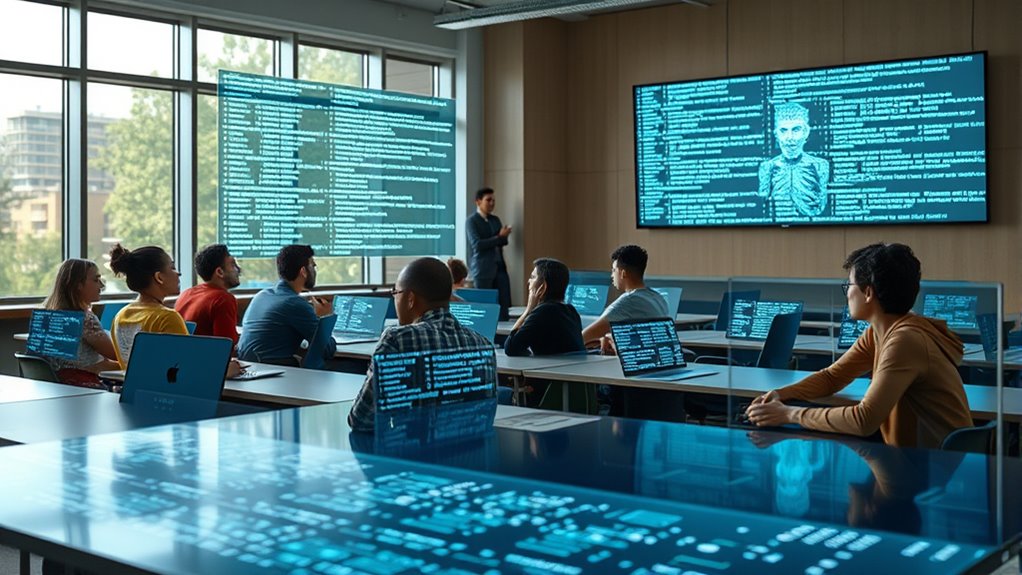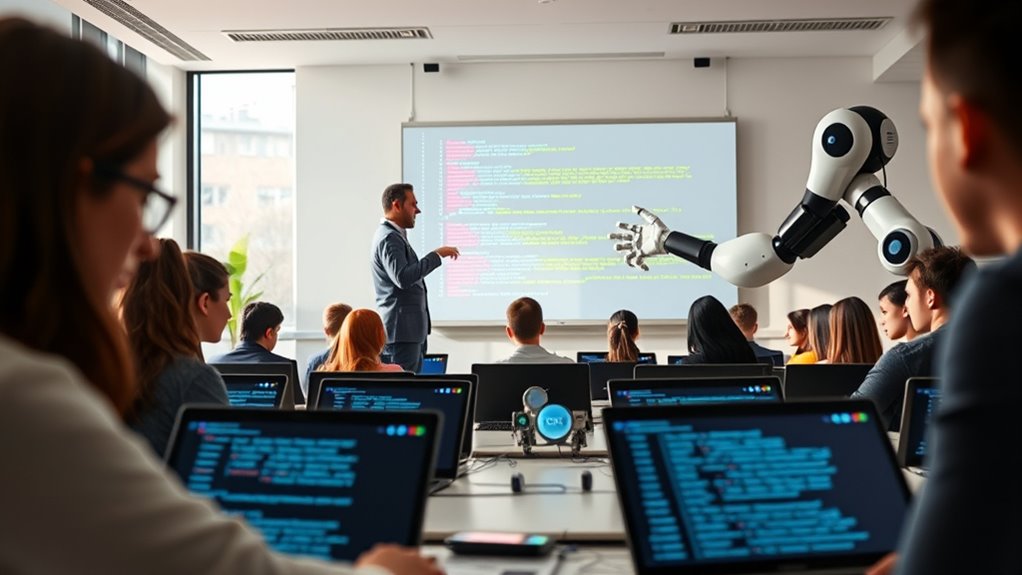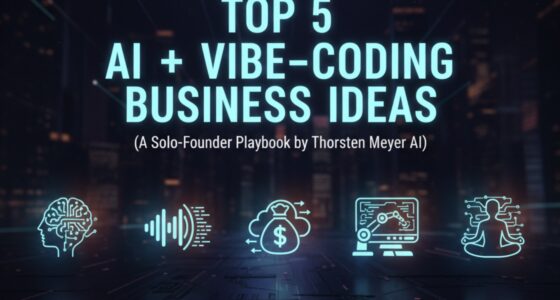In today’s AI-driven world, learning to code is more important than ever. It helps you develop digital literacy, enhances problem-solving skills, and opens up future job opportunities across industries. While you don’t need to be a professional programmer, understanding coding gives you an advantage in adapting to technological changes and participating in the digital economy. Keep exploring, and you’ll discover how coding can truly empower your future skills and opportunities.
Key Takeaways
- Coding enhances digital literacy, critical thinking, and problem-solving skills vital for adapting to AI-driven industries.
- As AI automates routine tasks, understanding coding empowers individuals to leverage and collaborate with emerging technologies.
- Widespread coding knowledge promotes inclusivity, reduces digital divides, and democratizes participation in the digital economy.
- Learning to code supports lifelong learning and adaptability amidst rapid technological changes influenced by AI advancements.
- While not everyone needs to become a programmer, foundational coding skills are increasingly valuable across all sectors and roles.
The Growing Role of Coding in Modern Education

As technology becomes increasingly integral to everyday life, coding plays a pivotal role in modern education. Schools are integrating coding into curricula from a young age, ensuring students develop essential digital skills early on. Platforms like Scratch and Blockly make learning engaging by emphasizing problem-solving and creativity. Coding camps offer hands-on experience with various programming languages, complementing classroom lessons. Early exposure helps students build critical thinking and debugging abilities, making coding a necessary skill rather than a niche subject. Education methods are evolving beyond traditional classrooms, incorporating online platforms, AR, VR, and AI components. This shift aims to prepare students for a digital future, emphasizing practical skills and adaptability in an increasingly tech-driven world. Recent trends show that gamification and project-based learning significantly increase engagement and retention among young learners. Additionally, incorporating comprehensive digital literacy into curricula ensures students are prepared for the evolving demands of a technology-centric society. Furthermore, integrating STEM toys into early education can reinforce foundational skills and foster interest in coding and engineering from a young age. Moreover, adopting innovative teaching techniques can enhance the effectiveness of coding education and better prepare students for future challenges. Introducing interactive learning environments, such as virtual labs and simulations, can further enhance students’ understanding and enthusiasm for coding concepts. Incorporating insights from AI in education can tailor learning experiences to individual student needs, making coding education more effective and accessible.
How AI and ML Are Transforming Coding Skills

AI and ML are changing the way you develop code by automating many tasks, from generating snippets to fixing bugs. These technologies boost your productivity and shift your skill set toward understanding data, math, and machine learning. As AI continues to evolve, you’ll need to stay adaptable and learn new skills to stay relevant in the future of coding. Additionally, the integration of automation in business is making programming more efficient and accessible for many users. Recognizing the importance of industry trends helps developers anticipate future demands and stay competitive in the evolving landscape. Moreover, advancements in natural language processing are enabling more intuitive interactions between developers and AI tools, further transforming coding practices. Staying informed about technological advancements in the field will be crucial for ongoing professional growth.
AI Enhances Coding Education
The rapid growth of artificial intelligence in education is transforming how coding is taught and learned. AI tools now speed up learning by generating code snippets, assisting debugging, and offering instant feedback. Nearly two-thirds of teachers use AI, showing its integration into classrooms. Personalized explanations help students grasp concepts more effectively, making learning more engaging. AI also simplifies complex coding tasks, reducing the need for deep mastery of every language detail. Additionally, AI can support emotional support by providing encouragement and tailored guidance to learners facing challenges. Incorporating Bitcoin IRA strategies into financial education can help students understand diverse investment options and risk management. As the use of AI expands, it is increasingly evident that educational technology plays a vital role in modern learning environments. Moreover, the integration of coding resources can further empower students by providing supplementary practice materials and tutorials. Developing software quality assurance skills can also help students ensure their projects meet high standards and are reliable.
Machine Learning in Practice
Machine learning is rapidly reshaping how coding skills are applied across industries. In finance, it powers algorithmic trading, risk analysis, and portfolio management, making financial systems smarter and faster. Reinforcement learning drives automation in robotics, self-driving cars, and industrial processes, pushing machines to learn from their environment. In agriculture and environmental monitoring, remote sensing techniques analyze land use and track climate changes. Healthcare benefits from machine learning through diagnostics, drug discovery, and patient data analysis, improving accuracy and efficiency. Industrial automation uses predictive maintenance and quality control to reduce costs and downtime. A thorough understanding of agricultural technologies will be essential for coders working on innovative solutions in farming and environmental sectors. As a coder, you’ll need to understand how to develop and integrate these models, enhance real-time processing, and optimize algorithms—skills that are essential in today’s transformed technological landscape.
Future Skills Demand
How are emerging technologies transforming the skills you’ll need as a coder? AI boosts efficiency by automating tedious tasks, generating code snippets, and streamlining maintenance. This shift lets you focus more on high-level problem solving and creative solutions. Additionally, developing mindfulness practices can help maintain focus and reduce stress during complex coding projects. Instead of mastering syntax, you’ll concentrate on understanding the “why” behind your work, blending creativity with productivity. As AI integrates into development, new roles emerge, such as AI ethics specialists and algorithm trainers, expanding career options. Coding literacy and computational thinking become essential, helping you interpret AI output and collaborate effectively with technology. While reliance on AI tools grows, your ability to adapt, analyze, and oversee AI-driven projects remains vital. AI is rapidly evolving and impacting daily work and job roles, automating tedious tasks, and accelerating product creation. Additionally, understanding related concepts like Ring Security Cameras can be beneficial for a well-rounded technological skill set. Developing skills in project management can also help coordinate complex AI projects effectively. Future skills demand a mix of technical expertise and strategic thinking in an AI-augmented landscape. Recognizing the importance of Kia Tuning skills, for example, can also be advantageous in specific technical fields. Developing strong Relationship communication skills can also help in collaborative tech environments, ensuring smoother teamwork and project success.
Accessibility and Engagement in Coding Learning

Using visual programming tools can make coding more accessible for learners with diverse needs, but not all platforms support everyone equally. Creating inclusive learning environments guarantees students stay engaged and can participate fully, regardless of background or ability. How can we better incorporate these tools and environments to make coding truly accessible for all? Incorporating smart features such as app control and scheduling can further enhance engagement and adaptability for learners with different abilities. Additionally, understanding the operating hours of support services can ensure learners receive timely assistance when needed. Furthermore, integrating personal development strategies can boost learners’ confidence and motivation throughout their coding journey. Recognizing the importance of accessible design in educational tools ensures that visual programming environments cater to diverse learning needs and promote equity in tech education. Emphasizing user feedback can guide continuous improvements to make these platforms more inclusive and effective.
Visual Programming Tools
Visual programming tools have revolutionized the way beginners and non-technical users approach coding by offering intuitive, visual interfaces that simplify complex concepts. With drag-and-drop features, you can build programs by manipulating visual blocks instead of writing lines of code. These tools provide real-time feedback and visual cues for errors, making debugging easier and learning smoother. Many also support collaboration, allowing you to work with others seamlessly. They’re designed to be cross-platform, so your projects can run on web, mobile, or desktop environments. Popular options like Scratch, Blockly, and Visual Studio Code extensions make coding accessible and engaging. By reducing technical barriers, these tools help you stay motivated and involved in learning programming, fostering confidence and creativity from the start. Additionally, visual programming tools often incorporate elements of bedroom design principles, such as clear and organized interfaces, which enhance user experience and reduce cognitive load during learning.
Inclusive Learning Environments
Creating inclusive learning environments in coding education requires addressing multiple barriers that diverse students face. Many schools lack widespread access to programming courses; only 14% make them mandatory, and just 20.8% offer them optionally. Rural, urban, and smaller schools are less likely to provide foundational computer science, limiting opportunities for many students. Underrepresented groups, like students with disabilities, multilingual learners, and economically disadvantaged students, often encounter additional obstacles due to limited resources and culturally irrelevant content. To improve engagement, curricula must reflect diverse perspectives, and teachers need targeted training to foster inclusion. Utilizing accessible tools and feedback mechanisms helps identify barriers and tailor support. Policy efforts play a vital role in expanding access, ensuring all students can benefit from coding education in an equitable, engaging manner.
Career Opportunities Driven by Coding Expertise

In today’s rapidly evolving tech landscape, having coding skills opens doors to a wide array of high-demand careers. The job market is booming, with software development projected to grow 21% by 2028. High-paying roles like Cloud Architects, Data Scientists, and Machine Learning Engineers are in fierce demand, driven by skills in Python, JavaScript, and Java. You can expect around 230,000 new IT opportunities annually through 2027. Tech careers aren’t just growing; they’re transforming industries worldwide.
| Role | Growth Potential | Salary Range |
|---|---|---|
| Software Developer | Fastest-growing sector | High, competitive |
| Data Scientist | 23.4% growth in 10 years | Very high |
| Cloud Architect | Increasing importance | Lucrative |
| Cybersecurity Engineer | High ongoing demand | Top-tier |
Challenges and Gaps in Current Coding Education

Despite the growing importance of coding skills in today’s job market, many educational systems face significant hurdles in delivering effective and inclusive coding education. Limited resources mean many schools lack the necessary hardware and software, making hands-on learning difficult. Inequitable access at home and school creates gaps, especially for students in underserved communities. Curriculums often focus on theory, neglecting practical skills students need. Funding cuts and outdated infrastructure further hinder progress. Teachers frequently lack proper training to teach coding effectively, leading to inconsistent standards. Additionally, online platforms face security concerns, and unreliable internet limits access for many students. Socioeconomic, gender, and geographic disparities exacerbate these challenges, leaving many students behind in developing essential coding competencies.
The Impact of AI on Future Coding Curriculums

The rapid advancement of AI is reshaping how we approach coding education, prompting schools to rethink their curriculums. AI is transforming the job market, making some traditional coding skills less relevant while creating new opportunities in AI development. As a result, there’s a shift toward including AI literacy as a core component of future education, helping students prepare for an AI-driven world. Schools are updating curricula to incorporate AI concepts, tools, and hands-on projects, enabling students to gain practical experience. AI-driven learning tools offer personalized feedback and assessments, making learning more efficient. However, integrating AI into education also presents challenges, like teacher training, resource needs, privacy concerns, and ensuring accessibility for all students. These changes will fundamentally influence how coding is taught in the future.
Is Coding a Necessary Skill for Everyone?

As our world becomes increasingly digital, coding is emerging as a foundational skill that everyone should develop. It’s no longer confined to tech companies—across industries, coding enhances problem-solving, decision-making, and innovation. Learning to code equips you with adaptable skills essential for the rapidly changing job market and boosts digital literacy, a core competency today. Consider this table:
| Skill Area | Why It Matters | Impact |
|---|---|---|
| Industry Use | Cross-sector problem-solving | Competitive advantage |
| Future Jobs | Adapts to evolving digital roles | Career growth |
| Digital Literacy | Fundamental understanding | Everyday tech navigation |
| Creativity | Fosters innovation | Leadership in tech sectors |
| Critical Thinking | Enhances logical reasoning | Better decision-making |
Coding isn’t just for programmers; it’s an essential tool for everyone to thrive in a digital world.
Frequently Asked Questions
How Can Beginners Start Learning to Code Effectively Today?
To start learning to code effectively today, you should focus on understanding fundamental concepts like algorithms and problem-solving. Choose a popular language like Python or JavaScript, and use free resources such as freeCodeCamp or Harvard’s CS50X. Practice daily through hands-on projects, and join online communities or social media groups for support. Incorporate AI-powered tools to help debug and grasp complex topics, making your learning more efficient and engaging.
What Are the Best Tools for Teaching AI and ML to Students?
Imagine a painter’s palette, filled with vibrant colors representing AI and ML tools. You can use Socratic by Google for step-by-step explanations, or TensorFlow and PyTorch for building models. Tools like ChatGPT and Quillbot help with understanding and writing. Visual learners benefit from DALL-E and MidJourney. These resources empower you to teach AI and ML effectively, turning complex ideas into accessible, creative projects.
How Do Coding Skills Influence Non-Tech Career Paths?
Coding skills considerably influence non-tech career paths by enhancing your analytical abilities, streamlining workflows, and automating repetitive tasks. With these skills, you can handle large data sets, identify trends, and make smarter decisions, making you more valuable in your role. Coding also opens up new opportunities for career growth, boosts your confidence, and allows you to contribute innovatively to your organization, regardless of your industry.
What Strategies Can Improve Diversity in Coding Education?
Think of diversity in coding education as planting seeds for a richer tech landscape. To improve it, support early exposure through community programs and inclusive curricula. Encourage teachers with resources and training, and foster peer collaboration. Embrace blind recruitment and mentorship to attract underrepresented groups. By creating welcoming environments, you open doors wider, ensuring everyone has a fair chance to grow, contribute, and thrive in the digital future.
Will AI Eventually Replace Traditional Coding Jobs?
You might wonder if AI will replace traditional coding jobs. While AI automates many programming tasks and could take over routine work, it’s unlikely to eliminate all human roles. Instead, you’ll see a shift toward more creative and complex problem-solving, with humans and AI collaborating. Developing skills like critical thinking and adaptability will be key, helping you stay relevant and thrive in an evolving, AI-driven coding landscape.
Conclusion
As AI reshapes the landscape, learning to code is like planting a seed for your future. While not everyone needs to become a software engineer, understanding the basics empowers you to navigate an increasingly digital world. Think of coding as a toolkit—equipping you to adapt, innovate, and stay relevant. Embrace it now, and you’ll find yourself steering the ship in this rapidly changing sea of technology.









